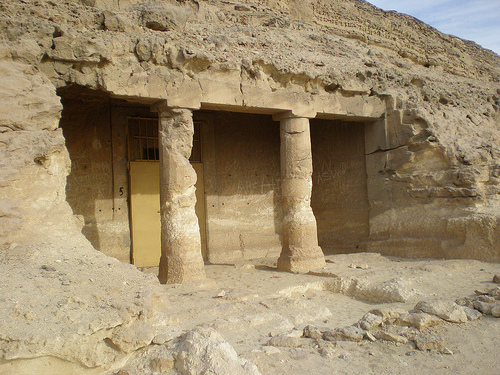

Location: 20 km (12 mi) South of Al Minya
Open: daily
Beni Hassan (Arabic: بني حسن) is a rock necropolis of the
Ancient and Middle Kingdom era in Egypt, a cultural and historical
monument. Located on the eastern bank of the Nile near the ancient
city of Menat Khufu, between the modern cities of El Minya and
Mallawi.
The Beni Hasan complex is carved out of rock and
contains 39 large burials of high-ranking ancient Egyptian nobles
and hundreds of tombs of lesser officials, the earliest of which
date back to the 6th Dynasty, and the latest to the XXX Dynasty.
According to the design of the tomb, they belong to three different
types:
one square room, sometimes with a vaulted ceiling
one rectangular room, the ceiling of which is supported by one or
two rows of papyrus-shaped columns with a capital in the form of a
closed lotus bud; each pair of such columns is topped by a common
architrave
a funerary complex with an open courtyard, a
rectangular portico with a vaulted ceiling, a square main chamber
with two rows of double columns with longitudinal architraves, as
well as a chapel with a statue of the deceased and, in some cases,
statues of his relatives. In tombs of this type, the columns of the
main room are 16-gonal in cross-section, and the columns of the
portico are octagonal in cross-section, have shallow longitudinal
grooves and square abaci supporting an architrave. The style of such
columns has been known since the time of Champollion as
“proto-Doric”.
In 12 of the large burials, inscriptions and
images have been preserved. The most richly decorated tombs of the
nomarchs of the XVI (Antelope) nome of the XI and XII dynasties -
Kheti I, his father Baket III, Khnumhotep II and Amenemhet (Ameni).
The wall paintings, executed on the lime plaster lining the walls,
contain scenes of hunting and fishing, agricultural work, sports
competitions, as well as offerings of funeral gifts and the
afterlife; the best known are the antelope feeding scene in the tomb
of Khnumhotep II and the ball game scene in the tomb of Bakti III.
From later eras, a rock chapel of the Greco-Roman period has
been preserved, on the cornice of which there is a cartouche with
the name of Ptolemy Alexander II, and traces of the life of Coptic
Christian hermits: one of the tombs (where the “ruler of the desert”
Neternecht was buried), judging by the wall depicting the alphabet
the mural probably served as a school, and the other as a church.
To the south of the complex is the underground temple of the
local lioness goddess Pakht, built during the reign of Hatshepsut
and Thutmose III. Since the Greeks identified Pakht, the patroness
of war and hunting, with Artemis, the temple was known to them as
the “Grotto of Artemis.”
BH2 - Nomarch Ameni
BH3 - Prince Khnumhotep II
BH4 - Nomarch
Khnumhotep IV
BH13 - scribe Khnumhotep
BH14 - Nomarch Khnumhotep I
BH15 - Nomarch Baket III
BH17 - Nomarch Kheti I
BH18 - Nomarch
Kheti II
BH21 - Nomarch Nakhti I
BH23 - "Overseer of the Eastern
Desert" Neternakht
BH27 - nomarch Ramushenti (11th dynasty period)
BH29 - nomarch Baket I (period of the XI dynasty)
BH33 - nomarch
Baket II (period of the XI dynasty).